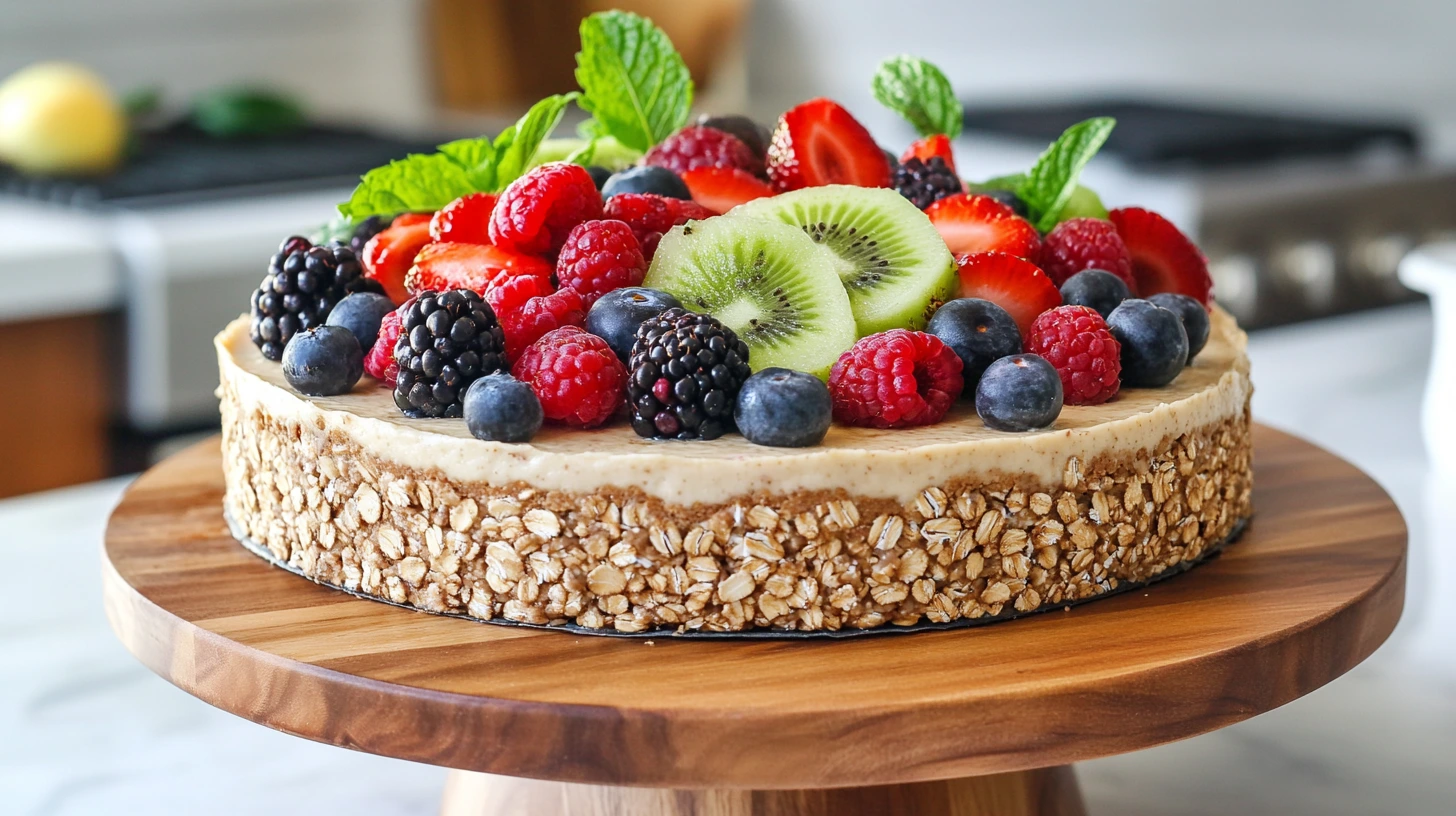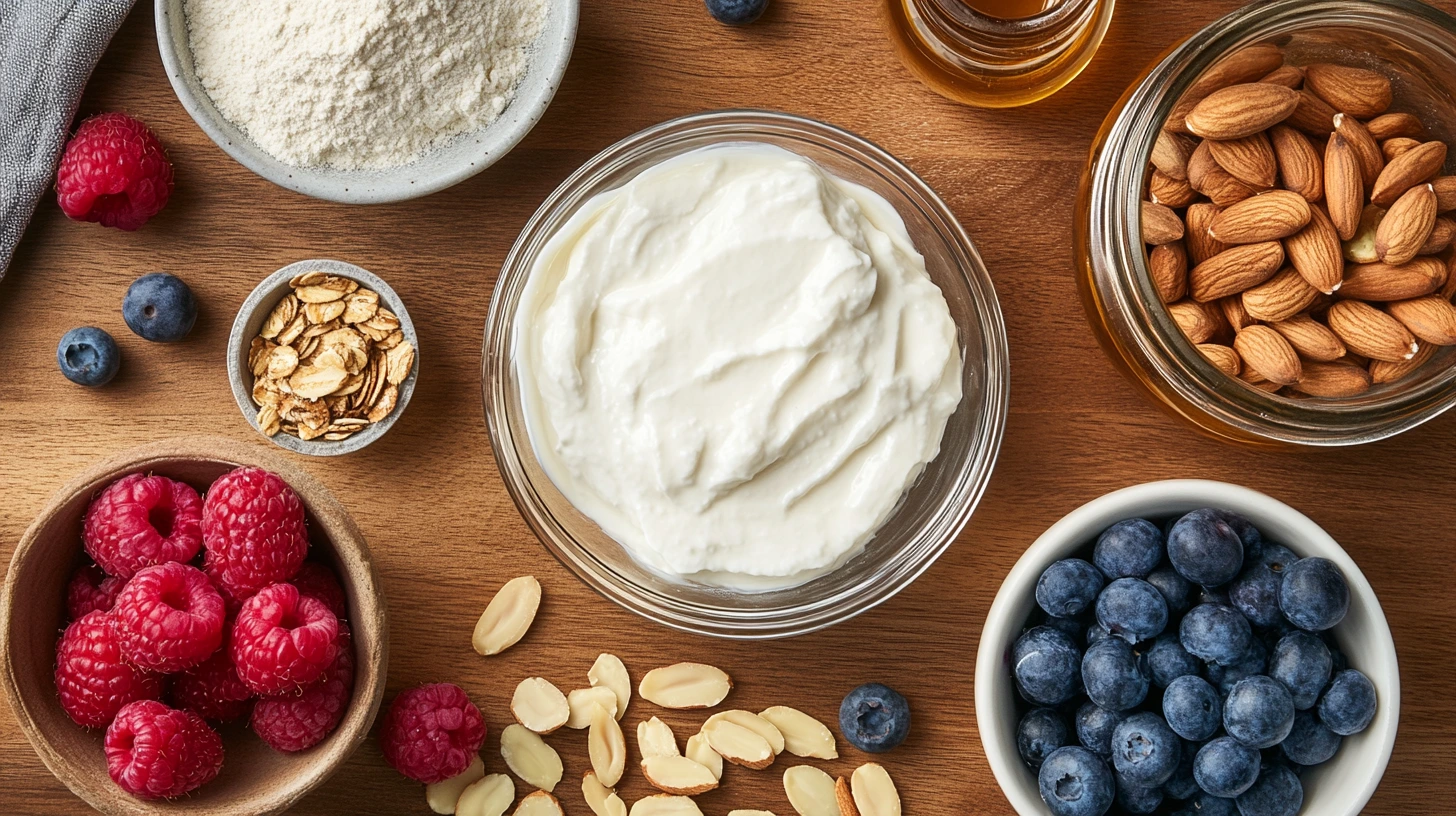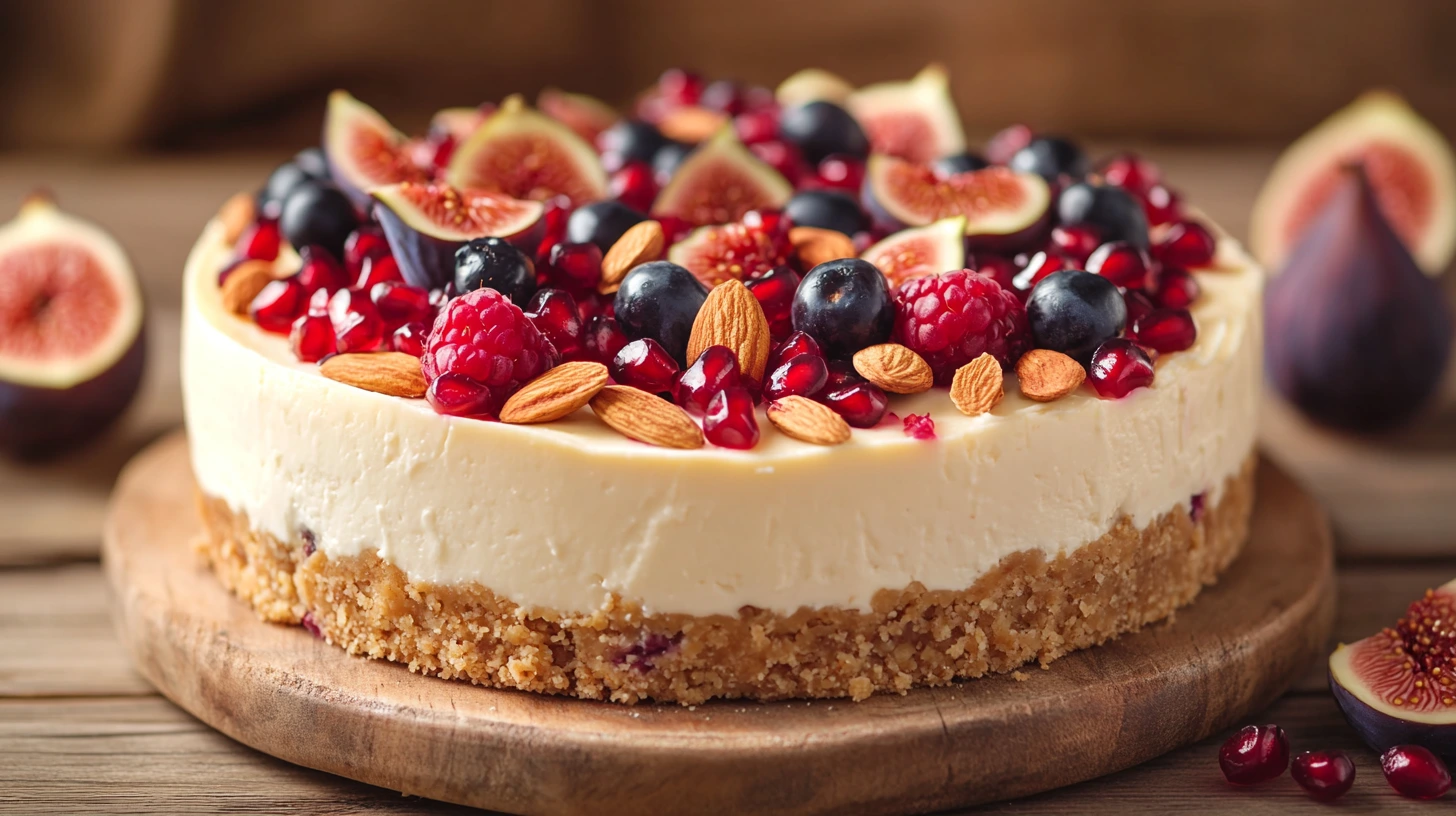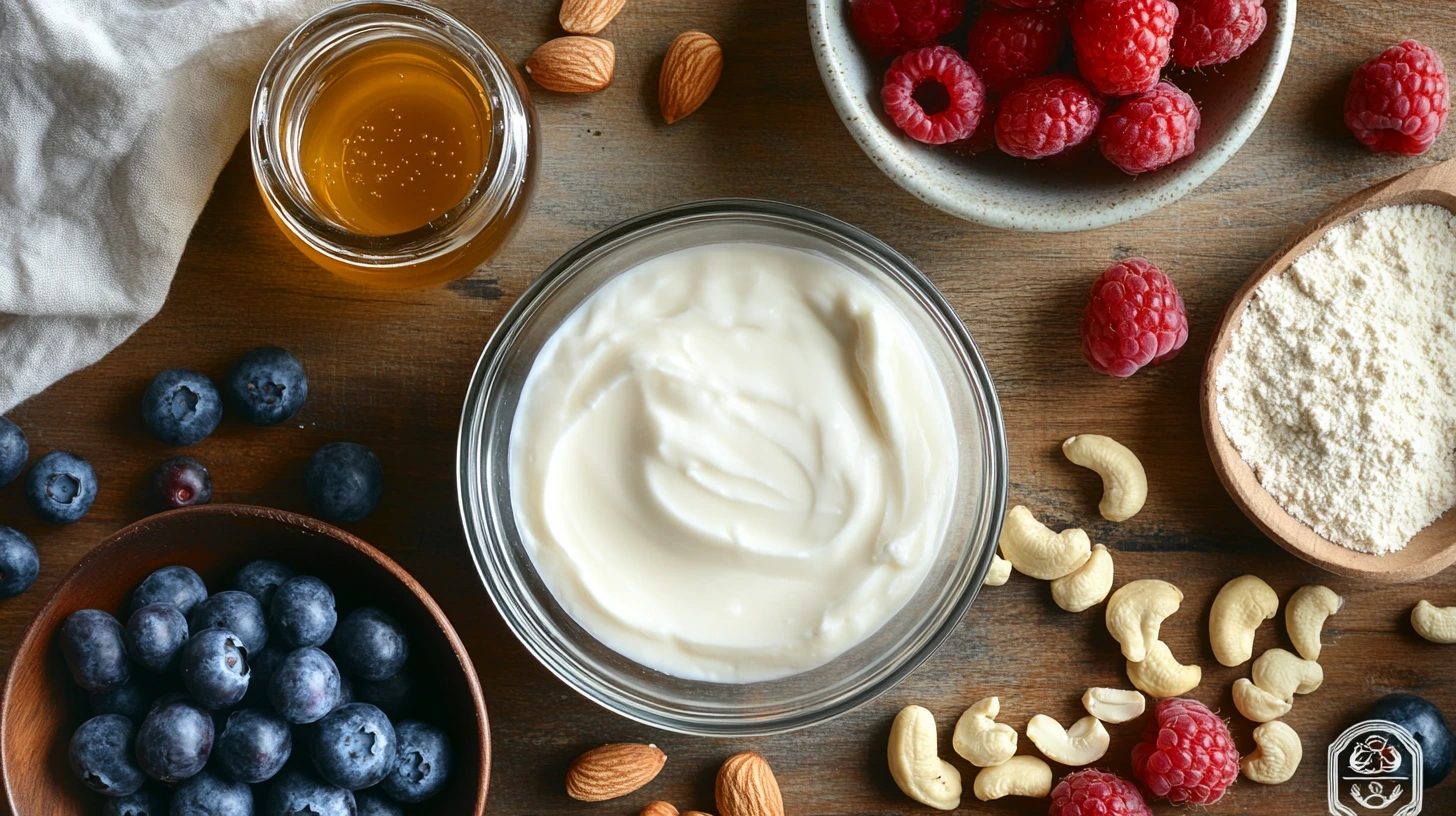
Table of Contents
Introduction to Healthy Cheesecake Recipe
What Makes a Cheesecake “Healthy”?
A healthy cheesecake recipe typically features modifications that lower calories, fat, or sugar while maintaining the rich and creamy texture that makes traditional cheesecake so beloved. Common changes include using lighter alternatives like Greek yogurt or reduced-fat cream cheese instead of full-fat cream cheese, using a whole grain or nut-based crust instead of a traditional graham cracker crust, and reducing or replacing sugar with natural sweeteners like honey, maple syrup, or Stevia. Additionally, healthier cheesecakes may incorporate fresh fruit toppings, which add flavor and nutrients without extra calories.
Why Choose a Healthier Cheesecake Recipe?
Choosing a healthier cheesecake recipe allows you to enjoy this indulgent dessert without compromising your dietary goals. Healthier versions of cheesecake can offer the same creamy satisfaction with fewer calories and less fat, making it a more guilt-free option for those looking to maintain a balanced diet. You can still indulge your sweet tooth while nourishing your body by using natural sweeteners and incorporating nutrient-dense ingredients. Healthier cheesecakes are also great for those with dietary restrictions, such as people following a gluten-free, low-carb, or low-sugar diet.
Key Ingredients for a Healthy Cheesecake Recipe

Low-Fat Cream Cheese and Greek Yogurt
For a healthier cheesecake, low-fat cream cheese and Greek yogurt are a great way to reduce fat and calories while still achieving a creamy, rich texture. Low-fat cream cheese offers the same tangy flavor as regular cream cheese but with less fat. Greek yogurt, on the other hand, adds protein and a slight tang, helping to balance the sweetness of the dessert. Together, they provide the creamy consistency that cheesecake is known for without the heavy calories.
Natural Sweeteners: Honey, Stevia, or Maple Syrup
Instead of refined sugar, natural sweeteners like honey, Stevia, or maple syrup can be used to sweeten your healthy cheesecake. These alternatives are often less processed and contain additional nutrients. Honey and maple syrup are rich in antioxidants and provide a more complex sweetness, while Stevia is a zero-calorie sweetener that can replace sugar without impacting blood sugar levels. Using natural sweeteners reduces your cheesecake’s overall glycemic index, making it a healthier option.
Why Choose Natural Sweeteners Over Sugar?
Natural sweeteners like honey, Stevia, and maple syrup offer several benefits over refined sugar. First, they are less processed and often retain more natural nutrients. For example, honey contains antioxidants and trace vitamins, while maple syrup is rich in minerals like manganese and zinc. On the other hand, Stevia has no calories or carbohydrates, making it ideal for those watching their calorie intake or managing blood sugar levels. Natural sweeteners can help you enjoy the sweetness of a cheesecake without the blood sugar spikes associated with regular sugar.
Healthy Crust Alternatives: Nuts, Oats, and Dates
Traditional cheesecake crusts are often made with processed graham crackers high in sugar and refined flour. You can use a crust made from whole ingredients like nuts, oats, and dates for a healthier alternative. Ground almonds or walnuts provide healthy fats and a satisfying crunch, while oats can add fiber and texture. Dates serve as a natural sweetener and binder for the crust, eliminating the need for added sugars. These healthy crust alternatives enhance the flavor and add nutrients like fiber, protein, and healthy fats, making your cheesecake more wholesome.
Step-by-Step Guide to Making Healthy Cheesecake Recipe
Preparation: Gather Your Ingredients
Before you start:
- Make sure you have all your ingredients ready. You’ll need low-fat cream cheese, Greek yogurt, natural sweeteners like honey or Stevia, eggs, and a healthy crust base from nuts, oats, or dates.
- Prepare the crust using your baking tools, such as a springform pan, mixing bowls, and a food processor.
- Preheat your oven to the appropriate temperature (usually around 325°F/163°C) so it’s ready once you prepare the cheesecake.
Making the Healthy Cheesecake Recipe Crust
The crust is an integral part of the cheesecake, and using healthier ingredients makes a big difference. Ground nuts, oats, and dates make a delicious and nutritious crust. These ingredients provide fiber, healthy fats, and natural sweetness without the added sugar or refined flour found in traditional cheesecake crusts.
How to Make a Nut-Based Crust
To make a nut-based crust:
- A food processor will pull raw nuts like almonds, walnuts, or pecans until finely ground.
- Add a handful of oats and a few dates to help bind the mixture together and provide natural sweetness.
- Blend everything until the mixture sticks together when pressed.
Once ready, press the crust mixture evenly into the bottom of your springform pan, ensuring it’s compact and well-formed. For extra flavor, add a pinch of salt or a dash of cinnamon.
Preparing the Filling for a Healthier Cheesecake
Combine low-fat cream cheese with Greek yogurt for a lighter filling for creaminess and tang. To avoid refined sugar, sweeten it with natural alternatives like honey, maple syrup, or Stevia. This combination provides the texture of a traditional cheesecake but with fewer calories and more protein.
Mixing Low-Fat Cream Cheese and Greek Yogurt
Start by softening your low-fat cream cheese so it mixes more easily. Blend the cream cheese with Greek yogurt until smooth and creamy in a large mixing bowl. You can use an electric mixer or a whisk for consistency. Add your natural sweetener of choice, and mix well until fully incorporated. You can also add a teaspoon of vanilla extract for extra flavor.
The Role of Eggs in Cheesecake Filling
Eggs play a crucial role in the cheesecake filling by providing structure and helping it set properly. They contribute to the creamy texture while binding the ingredients together. For a healthier option, you can use fewer eggs or substitute with egg whites for a lighter version, though this may affect the texture slightly. Be sure to mix the eggs into the cream cheese and yogurt mixture slowly and evenly, ensuring everything is well combined.
Baking Your Healthy Cheesecake Recipe
Once your filling is ready, pour it onto the prepared crust in the springform pan. Smooth the top of the cheesecake mixture with a spatula to ensure even baking. Place the pan in the oven and bake according to your recipe’s instructions.
Proper Baking Time and Temperature for a Creamy Texture
Baking your cheesecake at the right temperature and time is key to achieving a smooth, creamy texture. Bake at around 325°F (163°C) for about 50-60 minutes, until the cheesecake is set but still slightly jiggly in the center. The edges should be firm, and the top should not crack. You can place a water bath under the pan for a more even bake to keep the temperature steady. After baking, let the cheesecake cool in the oven with the door slightly ajar for about an hour, then refrigerate it for at least 4 hours or overnight to allow it to set completely.
Variations on Healthy Cheesecake Recipe

Gluten-Free Healthy Cheesecake Recipe
For a gluten-free version of healthy cheesecake, you can easily swap out the regular crust for one made from gluten-free ingredients. Instead of using traditional graham crackers, use ground almonds, gluten-free oats, or coconut flour. These alternatives provide a similar texture and flavor while safe for those with gluten sensitivities. Ensure all your ingredients, including sweeteners or flavorings, are also gluten-free.
Vegan Healthy Cheesecake Recipe
Making a vegan healthy cheesecake recipe is another excellent option for those following a plant-based diet. Traditional cheesecake contains dairy and eggs, but you can replace these ingredients with plant-based alternatives without sacrificing flavor or texture.
Using Cashews and Coconut for Vegan Cheesecake
Cashews and coconut are key ingredients in many vegan cheesecake recipes. Soaked cashews provide a creamy, rich texture that mimics the consistency of cream cheese. In contrast, coconut (in coconut milk, coconut cream, or shredded coconut) adds richness and a subtle sweetness. To make the filling, blend soaked cashews with coconut cream or milk and natural sweeteners like maple syrup or agave. You can also add some lemon juice or vanilla extract to enhance the flavor. Use dates, almonds, or walnuts for the crust to provide a delicious base. This vegan version is just as indulgent, creamy, and satisfying as the traditional cheesecake.
Toppings and Serving Suggestions
Low-Calorie Toppings for Your Cheesecake
When topping your healthy cheesecake, choosing low-calorie options can enhance the flavor without adding too many extra calories. Fresh fruits, like berries, are an excellent choice because they are low in calories, high in fiber, and packed with antioxidants. A sprinkle of chopped nuts can add texture and a bit of healthy fat, while a dollop of light whipped cream offers a creamy contrast without the heavy calories of regular whipped cream.
Fresh Berries, Nuts, and Light Whipped Cream
Fresh berries, such as strawberries, raspberries, blueberries, or blackberries, make a colorful and nutritious topping for your cheesecake. These fruits bring a burst of flavor and help balance the sweetness of the cheesecake. Nuts like almonds, walnuts, or pistachios can provide a satisfying crunch and healthy fats. For a lighter option, top your cheesecake with a small amount of light whipped cream, which offers the creamy texture you love but with fewer calories than traditional heavy cream. Together, these toppings create a beautiful and flavorful presentation that won’t overwhelm your healthier cheesecake.
How to Serve Healthy Cheesecake for Special Occasions
Healthy cheesecake can be just as festive and impressive as traditional cheesecake when served for special occasions. To make it extra special:
- Consider elegantly presenting the cheesecake. You can slice the cheesecake into small, bite-sized pieces for guests to enjoy as individual portions.
- For a festive touch, garnish each slice with mint, fresh berries, or even a fruit compote from low-calorie sweeteners.
- If you’re serving it for a holiday or celebration, sprinkle it with cinnamon or nutmeg for a seasonal flair.
Healthy cheesecake can be enjoyed for birthdays, holidays, or any special gathering without feeling guilty, and with the proper presentation, it will impress your guests.
Storing and Freezing Healthy Cheesecake Recipe
How to Store Your Cheesecake for Long-Lasting Freshness
Proper storage is key to keeping your healthy cheesecake fresh for as long as possible. After baking, allow the cheesecake to cool completely at room temperature. Once cooled, cover it tightly with plastic wrap or aluminum foil or place it in an airtight container to prevent it from absorbing any odors in the fridge. Store your cheesecake in the refrigerator for 4-5 days, depending on the ingredients used. If your cheesecake is topped with fresh fruit or whipped cream, it’s best to store these toppings separately and add them before serving.
Freezing Cheesecake for Later Enjoyment
Freezing cheesecake is an excellent option if you want to save it for later or make it in advance. To freeze your cheesecake, first make sure it has cooled completely. If you’re freezing the entire cheesecake, wrap it tightly in plastic wrap and aluminum foil to prevent freezer burn. You can also slice the cheesecake into individual servings for easy defrosting later. Store it in a freezer-safe container or bag, and label it with the date. Cheesecake can be frozen for up to 3 months. When you’re ready to enjoy it, remove the cheesecake from the freezer and let it thaw in the refrigerator for several hours or overnight.
Health Benefits of Healthy Cheesecake Ingredients

Low-Fat Dairy and Greek Yogurt Benefits
Low-fat dairy products offer several health benefits, such as low-fat cream cheese and Greek yogurt. They are lower in calories and fat than their full-fat counterparts, making them a better choice for those who want to reduce their calorie intake while still enjoying creamy textures. Greek yogurt, in particular, is rich in protein, which helps promote muscle repair and growth. It also contains probiotics, beneficial bacteria that support gut health and digestion. By incorporating low-fat dairy and Greek yogurt into your cheesecake, you can enjoy a creamy treat with added nutritional value, including calcium and protein, without the excessive saturated fats in traditional dairy products.
The Power of Nuts and Natural Sweeteners
Nuts like almonds, walnuts, and cashews are an excellent source of healthy fats, protein, and fiber. They provide heart-healthy monounsaturated fats, which can help lower harmful cholesterol levels and improve overall cardiovascular health. Nuts are also packed with vitamins and minerals, including vitamin E, magnesium, and antioxidants, which support overall health and well-being. When used in the crust or as a topping for healthy cheesecake, they add texture and a satisfying crunch, all while boosting the nutritional value.
Natural sweeteners like honey, maple syrup, and Stevia offer a healthier alternative to refined sugars. They contain fewer processed ingredients and retain some of their natural nutrients. Honey and maple syrup, for example, provide antioxidants, which help protect the body from oxidative stress and support immune health. Stevia is a zero-calorie sweetener, making it an excellent option for those looking to reduce their sugar intake without sacrificing sweetness. You can enjoy a healthier, lower-glycemic dessert option that doesn’t spike blood sugar levels as much as refined sugar using natural sweeteners.
Frequently Asked Questions (FAQs)
Can I Make Healthy Cheesecake Without Sugar?
You can make a healthy cheesecake without sugar by using natural sweeteners like honey, maple syrup, or Stevia. These alternatives provide sweetness without refined sugars’ added calories and sugar content. Additionally, some fruits, like mashed bananas or applesauce, can add natural sweetness while contributing to the cheesecake’s texture.
Is Healthy Cheesecake Suitable for Weight Loss?
Healthy cheesecake can be suitable for weight loss, especially with lower-fat ingredients, natural sweeteners, and a healthy crust. Reducing the calories and fats typically found in traditional cheesecakes allows you to enjoy a guilt-free dessert in moderation. However, portion control is key—while healthy cheesecake may be lower in calories, it’s still important to be mindful of serving sizes when incorporating it into your diet.
Can I Use a Dairy-Free Option for Healthy Cheesecake Recipe?
You can make a dairy-free healthy cheesecake by replacing dairy ingredients with plant-based alternatives. For example, use dairy-free cream cheese or coconut cream instead of regular cream cheese, and substitute Greek yogurt with plant-based yogurt. You can also use almond milk or coconut milk instead of regular milk. These substitutions allow you to enjoy a rich and creamy cheesecake without dairy, making it suitable for those with lactose intolerance or following a vegan or dairy-free diet.
How Do I Achieve a Creamy Texture in Healthy Cheesecake Recipe?
To achieve a creamy texture in a healthy cheesecake, it’s vital to use ingredients like low-fat cream cheese, Greek yogurt, or soaked cashews (for dairy-free options) that provide richness without being too heavy. Be sure to blend the ingredients thoroughly until smooth and creamy. Also, avoid overbaking the cheesecake, as this can cause it to dry out and affect the texture. Allowing the cheesecake to cool completely before refrigerating helps set the creamy texture.
How Can I Make Healthy Cheesecake Recipe Taste Just as Good?
To make a healthy cheesecake taste just as good as the traditional version:
- Focus on using high-quality ingredients and natural sweeteners that provide depth of flavor.
- Use vanilla extract, citrus zest, or a pinch of salt to enhance the flavor.
- Consider adding healthy fats like nuts or coconut oil to the crust for a richer taste.
Topping the cheesecake with fresh berries, a drizzle of maple syrup, or a light fruit compote can add flavor and a visually appealing touch.
Can I Make Healthy Cheesecake Recipe Ahead of Time?
Yes, healthy cheesecake recipe can be made ahead of time. Many cheesecakes taste even better after resting for several hours or overnight, as the flavors have time to meld together. After baking and cooling, store the cheesecake in the refrigerator, and it will stay fresh for up to 4-5 days. You can also freeze the cheesecake for more extended storage, up to 3 months. When ready to serve, let it thaw in the refrigerator overnight for the best texture.
Conclusion: Enjoying a Guilt-Free Healthy Cheesecake Recipe
A healthy cheesecake recipe allows you to indulge in a decadent, creamy dessert without guilt. By making simple swaps like low-fat dairy, natural sweeteners, and wholesome ingredients for the crust, you can create a delicious treat that fits into a balanced lifestyle. Whether you prefer a gluten-free, vegan, or classic healthy version, there are plenty of ways to enjoy cheesecake while still nourishing your body. With the right ingredients and portion control, you can savor a guilt-free cheesecake that satisfies your cravings and fits your dietary needs. So go ahead, indulge in a slice, and enjoy a healthier twist on a classic dessert!
Try this recipe tonight and tag us @biscsweet on social media and follow us on Facebook.
